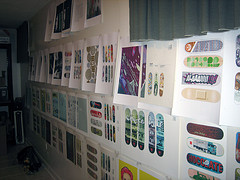Computer grids are made up of small rectangular pixels or cells. An image is created from these cells. The smaller the cells, the better the image quality, but this also increases the size of the data file needed to store the information. When an image is made up of a fixed number of pixels, each pixel has a certain size, and this can affect the appearance of the image, such as making it appear grainy (pixellated) when magnified.
Vector graphic files, on the other hand, store images as mathematical formulas consisting of lines, shapes, and colors. Vector graphics software displays an image with the highest possible quality by using these mathematical formulas to construct the image. The formulas determine the position of points in the image to produce the best results. These formulas can be scaled to any size, and as they are enlarged, the image quality remains the same, as does the size of the vector data file. Vector files are typically used for printing, but they can also produce sharp, high-resolution displays on screens.
Editing vector graphics involves using vector graphics creation and editing software. The software modifies the mathematical formulas representing the image objects. By applying mathematical operations, such as stretching, rotating, and changing the color of objects or components, the user can intuitively edit the image through the computer graphical interface. The vector image can then be displayed on a screen or exported as a bitmap file at any resolution for use on any device.
The size of a vector file is constant, regardless of the scale at which it is created. Therefore, converting a bitmap/raster file to a vector format is relatively easy, but going the other way, from a vector image to a bitmap/raster format, is more challenging, especially if the vector image has many individual components.
Vector formats are not always suitable for all image applications. For example, devices such as digital cameras and web browsers primarily work with raster images, as they do not have the capability to convert pixel-based images into mathematical formulas. Advanced imaging tools can combine vector and raster sources and provide editing tools for both types of images.
The W3C standard for vector graphics is SVG (Scalable Vector Graphics). Adoption of this standard has been slow and challenging due to the relatively low involvement of commercial interests. SVG data is still uncommon compared to other formats, but support for the standard is increasing in web browsers.
Vector drawings allow artists to achieve the desired results by adjusting colors and adding or removing details. The first use of vector graphics was in the U.S. SAGE air defense system, and vector graphics systems continued to be used in air traffic control and military applications. The vector graphics system Sketchpad, created by computer graphics pioneer Ivan Sutherland in 1963, ran on the MIT Lincoln Laboratory TX-2 computer. Vector graphics have also been used in arcade games such as Space Wars and home gaming systems like Vectrex.
Manuel Marino is a seasoned Senior Producer, Music Composer, and Artist with over a decade of experience. He specializes in branded entertainment across various mediums, including video games, films, and advertising campaigns. With 20+ years as a game music composer, Manuel has worked on numerous platforms, creating diverse orchestral soundtracks. HIRE ME


 Manuel is a passionate, driven, and techsavvy AV technician,
Manuel is a passionate, driven, and techsavvy AV technician, 

